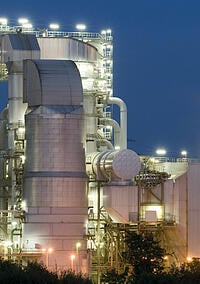The U.S. Environmental Protection Agency’s (EPA’s) plan to regulate carbon emissions is just the latest challenge facing the U.S. electric power system. Technological innovation is disrupting old ways of doing business and accelerating grid modernization. Earlier this year, AEE released Advanced Energy Technologies for Greenhouse Gas Reduction, a report detailing the use, application, and benefits of 40 specific advanced energy technologies and services. This post is one in a series drawn from the technology profiles within that report.
 Just as electricity is distributed over networks of wires to many buildings, it is also possible to distribute heating and cooling via networks of pipes. District energy systems produce steam, hot water, and/or chilled water at central plants and, through a network of insulated pipes (often underground), distribute the steam or water to multiple buildings. District energy plants often include power generation, typically CHP, which further increases overall efficiency.
Just as electricity is distributed over networks of wires to many buildings, it is also possible to distribute heating and cooling via networks of pipes. District energy systems produce steam, hot water, and/or chilled water at central plants and, through a network of insulated pipes (often underground), distribute the steam or water to multiple buildings. District energy plants often include power generation, typically CHP, which further increases overall efficiency.
The U.S. is currently home to over 700 operating district energy networks, spread across all 50 states. These systems primarily serve downtown areas, college and medical campuses, airports and military bases. For example, Veolia Energy operates a district energy system in the Boston-Cambridge area that uses the waste heat of a gas-fired electric power plant to produce steam, reducing 150,000 tons of of CO2 emissions per year through offset generation.[1]
By accommodating a variety of fuel types (natural gas, heating oil, geothermal fluids, etc.), district energy systems can reduce cost by switching fuels during periods of price volatility. District energy systems also allow buildings to eliminate the cost of installing, operating and maintaining heating and cooling equipment, reducing upfront capital costs for new buildings as well as reducing maintenance costs while freeing building space for more valuable uses. Since large chillers tend to be more efficient than smaller chillers or air conditioning units, district cooling systems can cut afternoon peak electricity demand, reducing strain on the electricity grid and avoiding peak power costs for building managers. Centralized heating and cooling services create emissions benefits associated with more efficient use of fuel, especially when CHP is part of the plant.[2] Some district energy systems also take advantage of locally produced renewable fuels, which further decrease greenhouse gas emissions.
[1] Advanced Energy Economy, Veolia Energy Case Study, http://info.aee.net/case-studies
[2] Some of the efficiency benefits are offset by losses in distribution. Thus, efficient distribution is very important.
